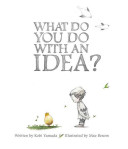Title: What do you do with an idea 
Author: Kobi Yamada
Illustrator: Mae Besom
Publisher: Compendium Inc. (2014)
Pages: 36
Tags: Self-Acceptance. K-4. Multicultural. Ideas. Picture-book. Ian Simmons
Genre: Fiction
What do you do with an Idea is about a young child who learns to embrace the idiosyncrasies of their idea, and therefore themselves. The child struggles with the idea as it refuses to leave them alone. The child then learns how to accept their idea in spite of other’s views and the child’s own reservations about their idea. Upon complete acceptance of the idea the child’s world changes with the utmost beauty. The child goes through phases of their relationship with their idea:
- Indignation— Initially the child disregards their own idea
- Fear— Upon realizing the idea hasn’t gone away the child tries to cover it up, worrying what others might think of the idea
- Curiosity— The child begins to like the idea and lets it follow them and begins to a pay attention to the idea
- Acceptance— The child fully allows the idea to follow them around and literally and metaphorically plays with the idea
- Rejection— Upon seeing others reaction to their idea the child briefly abandons the idea
- Reacceptance— The child realizes their idea is special and continues to play with it and “feed” it and make it grow
- Attention-giving and Fruition— The child gives a generous amount of attention to the idea and the idea grows to illuminate all things
Firstly, the child of the story is of Asian descent, but the child is also androgynous and is never identified with gendered pronouns. So, this book could be good not only in representing Asian-American or Asian students, but also in both binary and non-binary gender identities. A majority of the book is drawn in a pencil-sketch style with vibrant water colors initially isolated to “the idea” (represented as a golden egg with bird-like legs and a crown). Moreover there is always a lot of natural growth, or life itself, surrounding the idea. When the child first “meets”their idea on the first page, the two stand atop a world that is imaginative, yet colorless except for the idea itself and a small patch of grass it stands on. These ideas in conjunction with each other emphasize and represent the life that ideas bring to the world we perceive. As the child walks away in their initial rejection of their idea, the child walks into empty space, but drags a piece of the world their idea creates along with themselves indicating that idea is not just something outside oneself, but part of oneself; and again emphasizing the point that the idea holds the “life” of the world.
All the pages of the book are “unframed” and lacking boarders to give a sense of the boundlessness of the universe. To that end, white space is used not just as a symbol for lack of vibrancy and life, but as a place where all the imagination of the idea can grow into. Moreover, when the child rejects the idea in response to others, the idea looks smaller than it did on the page before and the page becomes emptier perhaps showing in a palatable way that rejection of one’s own ideas not only kills what the idea might become, but kills the world around us too. The rejection is short lived, however, as immediately following that page, the child continues to accept the idea and the idea becomes larger still. From the beginning of the story to the end the idea grows larger and larger as the child learns to cope with the existence of the idea to show development and growth of not only the idea itself, but the world around which the child cares for their idea and the child themselves, as the idea is a part of the child. As the child accepts their idea, and their idea continues to grow, the pages become filled with more life and more imaginative situations until “one day” when the idea hatches and the world of the child becomes full-colored.
The author uses the phrase “became a part of everything” to which the image adds the concept that our ideas shape the world around us. This is the primary ideology of the book, that in spite of our reservations and other’s judgments about our ideas, they influence how we see the world, and to have a healthy relationship with your own intellect and your own thoughts makes the world a colorful, bright, limitless, fun and happy place to live.
